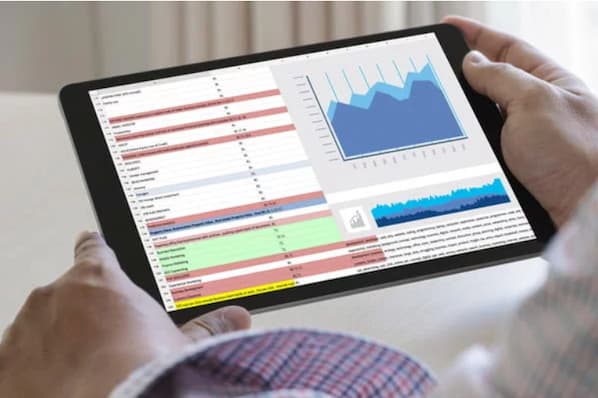You've poured thousands of dollars into your Pay-Per-Click (PPC) search campaigns and have managed to generate a substantial number of leads. You're rocking your conversion rates and your cost per lead is great.
What's the problem?
It's only when you start analyzing your results and dig a little deeper that you realize an overwhelming majority of these leads are in essence “junk leads.” Very few are turning into opportunities, let alone customers. The bottom line is, you're just not seeing a healthy ROI.
Free Guide, Template & Planner: How to Use Google Ads for Business
In this post, we provide 10 proven strategies that you can use to generate better quality, bottom of the funnel leads from your B2B PPC campaigns. Let's dive in.
PPC Lead Generation
1. Set up proper URL tracking.
To accurately measure the effectiveness of your campaigns, you need to make sure that you are able to track other important elements besides conversions. This data will allow you to determine which campaign and site a lead came from, the keyword they searched for, the device they were on, and so on.
One of the best ways to accomplish this is to use UTM Parameters and ValueTrack Parameters. These tags are data that you append to the end of your landing page URLs, and you've probably seen them when you clicked a link or ad. They look something like this
http://www.yourlandingpage.com/?utm_source=google&utm_medium=cpc
As a best practice, you should use the naming convention specified below and use at least these 6 parameters in your URLs:

In Google Ads, the most efficient way to set up tracking parameters is in the “Campaign URL options (advanced)” section under campaign settings. Here, you can enter your parameters after “{lpurl}?” as shown below. The {lpurl} portion will be automatically replaced with the landing page URL that you have set up for each ad within your campaign.
![]()
2. Determine where your opportunities are coming from.
Once you have your tracking parameters, you need to capture them on your landing pages and store them -- along with with other lead details -- into the contacts database of your marketing platform. This is usually done by creating hidden fields in your landing page form. You'll need one field for each UTM parameter that you have passed to your landing page:

You might first need to create custom fields or properties in your contacts database before you map them to the new hidden fields in your form.
Next, you need to make sure that your contacts or leads data is synced with your CRM and that you're able to view all opportunity data for your leads.
At a minimum, you should be able to view lead status or stage -- whether they are a sales qualified lead, marketing qualified lead, opportunity, or customer -- and the opportunity size or deal amount. If you have lead scoring data associated with each contact, this will be extremely beneficial as well.
Once you have all of the available data, you should create reports to isolate and segment it.
The most important data you want to extract are:
- The number of opportunities, opportunity amount, and customers won for each source, campaign, keyword, and device.
- The name, email, company, lead status/stage, lead score, opportunity amount, source, campaign, keyword and device for each lead.
You'll then be able to determine which opportunities are being generated from a particular search engine, campaign, device and keyword.
When you combine this with the spend data from your ad platform, you'll be able to get your true ROI.

Next, isolate poor quality leads. If you use lead scoring, look at the leads with the lowest scores. Otherwise, look for leads that have provided invalid or junk data in the name, email and company fields. Then check to see what campaigns, devices or keywords these leads have in common.
3. Segment your campaigns into many groups.
Many companies make the mistake of setting up campaigns or ad groups for each product or service they have. They don't dig deeper into the many different ways in which their target audience is searching for the solutions they offer.
You can address this by carefully planning your campaigns in order to segment your offer into as many groups as possible. You can segment by each main feature, benefit, sub category, target industry, or geographic location relevant to your product or service.
For example, let's say you provide web design and development services. You can segment your campaigns as follows:
- Sub-category: Ecommerce website design, custom website design, responsive web design, etc.
- Feature: WordPress web design, Magento Development, PHP development
- Benefit: high end web design, agile web development, enterprise web development
- Target industry: real estate website design, restaurant web design, healthcare website design
- Geographic location: San Francisco web design, California web design, New York web design
Once you identify the segments you want to go after, you can set up each campaign with the necessary assets:
- Keywords: All keywords related to the associated segment
- Ads: Ad copy customized to that segment
- Landing Pages: Customized landing page that has content only about that segment
Setting up campaigns in this way allows you to focus your efforts, and will result in better quality leads and increased conversion rates.
4. Target relevant keywords.
Keywords are at the heart of every paid search campaign, and you need to go wide and deep to identify the best ones for your business.
The first step is identifying the most focused and relevant keywords. Segment your campaigns as described in the previous section and then search for keyword ideas within each segment. There are a lot of excellent keyword research tools that you can use to find the best keywords.
To attract the best quality leads at the bottom of the funnel, you have to target keywords with searcher intent in mind. For example, when someone searches for “WordPress website design services” you know that they're looking for a company that provides WordPress services.
However, when someone just types in “WordPress website design,” you can't be certain about their intent.
They could be looking for services or they could just be looking for a how-to design guide. Location-based searches also convey searcher intent adequately. For example, “San Francisco web design” indicates that the searcher is looking for a web design company in San Francisco.
Based on the volume of searches, you can also decide to further segment your campaigns to get even more focused. The more tailored your campaigns are—including keywords, ads and landing pages—the better your leads will be.
For example, you could create a new campaign that combines two of the segments we just discussed titled “San Francisco WordPress website design.” Some of the keywords in this campaign could be:

Another way to get more focused with the keywords you're targeting is to find long-tail keywords -- those that consist of four or more words. Searchers who type in these longer search terms have typically done their research and honed in on exactly what they are looking for, making them quality prospects.
A good tool to find long-tail keywords is Übersuggest, but you can also source them directly from Google. After conducting a search, simply scroll down to the bottom of the page and look in the section “Searches related to…”
A search for “ecommerce design services,” for example, shows the following suggestions:

5. Filter out irrelevant keywords.
Targeting the kinds of keywords we discussed in the previous section, will go a long way in attracting high quality leads to your ads, but there are also steps you can take to proactively ward off less desirable clicks.
Look over your Search Terms Report to determine whether you are getting any irrelevant clicks to your ads. If you find any such clicks (or impressions), add those keywords to your negative keywords list -- this tells Google or Bing not to show your ads for any of these keywords.
Going back to our earlier example of web design services, some negative keywords you would likely want to add are: cheap, free, themes, school, jobs etc. This will make sure you don't waste your money on clicks from users searching for keywords like “San Francisco web design jobs” or “WordPress website design theme.”
If you followed our guidelines for tracking and opportunity attribution described in sections one and two, you'll now have the ability to determine which keywords are leading to poor quality leads and which keywords are producing opportunities.
If you find that certain keywords are predominantly producing poor leads, you can add them to your negative keywords list to stop receiving traffic from these types of searches.
On the other hand, you'll now have a list of keywords that have produced opportunities (and customers) for your business.

You can double down on these keywords in three ways:
- Increase their bids so your ads rank at the top of search results.
- Segment these keywords into a new group or campaign so you can have more customized ads and landing pages for them.
- Find other related keywords you may have missed the first time.
If you need help determining strong keywords and negative keywords, it can be helpful to use a template or build a keyword plan for your campaigns. Here's a guide that walks through how to use our free PPC campaign management template.
6. Use ad copy to pre-qualify visitors.
Writing ad copy that focuses solely on increasing click-through rates is a mistake. You should write ads that pre-qualify visitors, so that the traffic you do get will be a lot more relevant and targeted to your business. Some of the best ways of doing this, are by adding the following elements to your ad copy.
Business size
If you target businesses of a certain size, reflect that in your ad copy. For example, if you want to target larger businesses, you can add “enterprise” to your ads and create copy such as, “enterprise class WordPress design.”
Industry
If you work with specific verticals, you can make that clear in your ads. For example, your ad could read: “WordPress design for healthcare.” This usually works best with segmented campaigns and keywords (see tips three and four).
Pricing
Many companies are uncomfortable adding pricing to their ad copy, but this is a good way to weed out prospects who may not have the budget for your solution. You can do this by adding text such as, “Starting at $499/month,” or “Packages starting at $10,000.”
Target Persona
Including your target persona in your ad copy is another excellent way of pre-qualifying your ad traffic and even personalizing your ads. You can do this with text such as “For small business owners” or “For discriminating marketing executives.”
It's also important to consistently A/B test your ads to optimize their performance. As a general guideline, you should always have two ads running for each ad group in your campaigns.
You can then decide which ad is performing better by looking at the number of conversions and opportunities generated from each, in addition to the click-through rates.
7. Develop tailored landing pages for your ad groups.
Once a visitor gets to one of your landing pages you've already paid for the click. This means that measures such as adding extra form fields or validating for a business email address in an effort to reduce the number of poor-quality leads, are misguided. Instead, you should focus on maximizing the conversion rates of your landing pages by optimizing the elements below.
Tailor your landing pages to the needs, wants, and challenges of your ad groups with particular focus on the content you have above the fold.
It's ideal to create unique landing pages for each ad group. But, sometimes this isn't feasible -- especially if you're working with dozens of different ad groups.
Should this be the case, you can use dynamic headlines and subheadings on your pages. This will let you alter the content of your landing pages by passing in headlines and sub headings as parameters of your landing page URL.
It's also important to follow key landing page best practices to nurture those who click into converting. These include no navigation, a content or coupon offer in exchange for information, and imagery or visuals that add more information about whatever is being offered on the page. Still not sure where to start? Use these great design examples for inspiration.
Determine which offers drive the most results.
Test multiple offers to see which get the most traction. Make sure you look beyond conversions to see which offers are producing the most opportunities. Some offers to test include: free trials, demo scheduling, free evaluations, consultation requests, proposal requests, and free assessments.
Test, test, test.
A/B test your landing pages to determine which variants are driving the most conversions, opportunities, customers, and ROI:

Always A/B test a single element at a time to isolate the effect of that element on performance. Also, test only two variants of the page at a time.
The most important elements you should run tests on are above the fold. These include:
- Headline: Test different versions of your main selling point, benefit, or offer.
- Call-to-Action (CTA): Try out different CTA copy, colors, sizes, and placements.
- Hero Shot or Background: Test different images or videos for your hero shot or background.
- Form: Test different lengths and placements for your lead generation form. You might display your form in the hero area, at the bottom of your page, or as a popup.
8. Use your competitors for keyword inspiration.
If your competitors are getting precious real estate on search engine result pages, look into their strategy. Try using similar keywords and calls to action without blatantly copying them.
While knowing what your competitors are up to can be beneficial for your strategy, you should be sure to avoid using their branded keywords in your ads. This might make you look less credible, and Google may penalize you. Learn more about that here.
9. Make adjustments based on mobile performance.
If you implemented device tracking as described in tips one and two, you'll be able to determine which devices (computer, tablet, or smartphone) are driving opportunities. If you find that mobile leads are not converting into opportunities, you can stop running your campaigns on mobile devices or reduce bids so that computers and tablets receive the bulk of your traffic.
10. Create an ad schedule.
Even if you are running your ads 24/7, you should set up an ad schedule for your campaigns. You can add days of the week or break your schedule down further by adding hourly segments for each day. Once you schedule your ads, you'll be able to track performance for each day or hourly segment that you define:

By combining opportunity data and your ad schedule, you can determine which days or hours produce the most opportunities. From there, you can adjust your bids for each segment or stop running your campaign for those segments.
You should typically look at this data over a longer period of time -- at least one quarter. If you find that you're not generating any opportunities on weeknights or weekends, you could stop running most of your campaigns during those times and move your budget over to regular business hours.
PPC campaigns are an effective way to attract B2B leads. However, many companies struggle at generating opportunities and driving a positive ROI from their campaigns. The 10 strategies above will help you create targeted campaigns optimized for high quality lead conversions. They might help to boost your bottom line.
PPC




![How to Perfectly Manage a PPC Campaign [Template]](https://53.fs1.hubspotusercontent-na1.net/hubfs/53/120_Manage-a-PPC-Campaign.jpg)
![How to Build Pay-per-Click Marketing Campaigns [+ Best PPC Platforms, Tools, and Software]](https://53.fs1.hubspotusercontent-na1.net/hubfs/53/ppc%20blog.png)




![When and How to Build International PPC Campaigns [+ Best Tools, Examples, and Best Practices]](https://53.fs1.hubspotusercontent-na1.net/hubfs/53/international%20ppc.png)

